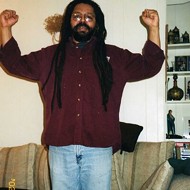I saw purple spots. I saw yellow spots. I saw green spots. I saw orange spots.
No, I wasn't tripping on some hallucinogen. I was looking at the map of Detroit on display at the City Planning Commission's public hearing on the zoning ordinance for the city's Medical Marijuana Caregiver Centers. Each of the colored spots represented the schools, churches, parks, liquor stores, strip joints, and whatever else the proposed centers would have to be at least 1,000 feet away from as the zoning ordinance is currently written.
The colors covered up most of the city.
And then there were the black areas. Those were where the Caregiver Centers would be allowed. Those are in districts zoned B2 and B4 (business districts), and those zoned M1-4 (industrial areas). There was a chunk of black on the far east side somewhere north of Jefferson, another on East Eight Mile Road, one on Woodward Avenue northbound near Highland Park, something on the west side near Telegraph and I-96 and a big bunch on the far Southwest side. Even within those black areas the centers would have to be at least 2,000 feet away from each other, or from a party store where alcohol is sold.
Mostly the map seemed to depict that the centers would be pushed out to the edges of town. There were some black dots sprinkled throughout the city, but you had to strain your eyes to find them on the big map displayed at the front of the Erma L. Henderson Auditorium. The people who oppose medical marijuana storefronts were thrilled. They don't want to see them in their neighborhood and they couldn't see them on the map.
The patients and storefront business owners who were there to defend themselves were similarly disheartened at the colorful display of spots. If what they saw were to go into effect most patients would have to find their medicine somewhere else.
Then the testimony for or against the proposed law began. Right off the bat City Council member Raquel Castaneda-Lopez got up to point out that District 6 on the Southwest side, which she represents, is largely made up of industrial zones and she didn't necessarily support pushing most of the centers there.
Some 70 people got up to speak their two minutes. The vast majority of the opposition came from the Rosedale Park area and neighborhoods to the north where the opposition forces have organized. They are alarmed at what they see along Grand River Avenue and Seven and Eight Mile roads. They got there early and signed up to speak so the early testimony was overwhelmingly in support of squeezing the centers out as much as possible. Most of them had gone by the time those who supported a more liberal approach were in the majority.
Most of the testimony on either side was not to the point. The hearing was not to argue whether marijuana is medicine or not — or if God is on your side. However there was one substantive concern that was noted. Some folks asked that the centers not be allowed in B4 (general business district) areas.
I didn't plan on sitting for five-and-a-half hours to witness the entire hearing, but that's what it took. One thing I learned is that among the public, the commissioners, and other city departments involved, there are those who seem to welcome the Caretaker Centers, as well as those who'd just as soon shut 'em all down tomorrow. And then there are those who just want to seriously examine the subject. They know marijuana is coming down the pike and they've never had to do something like this before. They want to get it as right as they can the first time and try to anticipate as many consequences of their actions as possible.
That's why the discussion after the public testimony was more revealing than that.
That said, most of the officials in the room agreed this ordinance as it stands is a work in progress and there will probably be some tweaking. As commissioners discussed the issue they asked questions of city employees from various departments involved in developing the ordinance. Then a second map came out with dots of an entirely different order.
The new map had purple spots spread across the city for the locations of schools. The 1,000 yard drug free school zone is federal law and it's non-negotiable. However the other distances are determined by the city. Along with the numerous purple spots were 10 big green ones. These zones related to some of the busiest intersections of the city. There was discussion about only allowing centers in these areas, where the idea was that various caregivers would join together in creating up to six major centers per zone.
It's an ongoing discussion. The commissioners want to look at a map where you take into account shorter distances from the churches and parks. Then there was some talk about creating some kind of enterprise zones in the industrial areas. There is concern to avoid any lawsuits that may arise. The whole thing ended about 10:40 p.m. because everyone had to get their cars out of the city lot by 11.
A few things are clear: There will be more discussion and the ordinance as written will see some changes, although it's not clear which direction those changes will go. And there are going to be fewer Caretaker Centers in Detroit than there are right now.
As we were headed out I asked a city worker nearby if we will be going through all this again when recreational marijuana gets legalized. His answer: "Yep."






